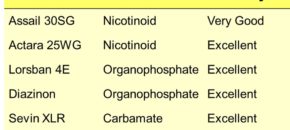Cucurbit downy mildew has been reported on cucumber in southern New Jersey (Salem County). This is the first report of CDM this growing season in the state. All cucumber growers are encouraged to scout fields on a daily basis and begin preventative fungicide programs if already not initiated.
Continue reading...New Jersey Sheep and Fiber Festival will be held on September 7 – 8, 2019
The 25th Annual New Jersey Sheep and Fiber Festival will be held on September 7 – 8, 2019. The event will take place at the Hunterdon County, New Jersey Fairgrounds. Plan to attend the New Jersey Annual Sheep & Fiber festival sponsored by the Garden State Sheep Breeders. There are breed demonstrations and competitions, showmanship […]
Continue reading...Hackettstown Livestock Auction Results for July 2, 2019
This auction sells: lambs, sheep, goats, calves, beef cattle, pigs, rabbits, and all types of heavy fowl. Auctions are held every Tuesday with the first sale beginning at 10:30 am and ending at the last sale 5:30 pm. Hay, straw, grain, and firewood are also for sale. Farm Fresh Eggs available for purchase by the […]
Continue reading...IPM Update 7/03/19

Sweet Corn A few European corn borer (ECB) moths were captured this past week, but numbers are very low, and no map will appear in this edition. It is unclear at this stage if these individuals represent the onset of a second flight. Catches over the upcoming week will clarify the situation with this pest. […]
Continue reading...Fruit IPM For 07/03/19
Peach: Oriental Fruit Moth: Second generation timings are updated below. Second flight adults are still flying statewide. Treatments for the second generation have just finished in statewide. Applications for OFM should now be made only if trap captures exceed and average of 6 moths/trap.
Continue reading...Post-bloom Insect Pest Control Recommendations

As we approach the end of bloom, growers should consider the need for any post-bloom applications. The main pest targets for these applications are mainly Sparganothis fruitworm and spotted fireworm. Sparganothis fruitworm (SPARG) – If your farm has high pheromone trap counts, you should consider managing this pest as soon as bees are removed. The […]
Continue reading...